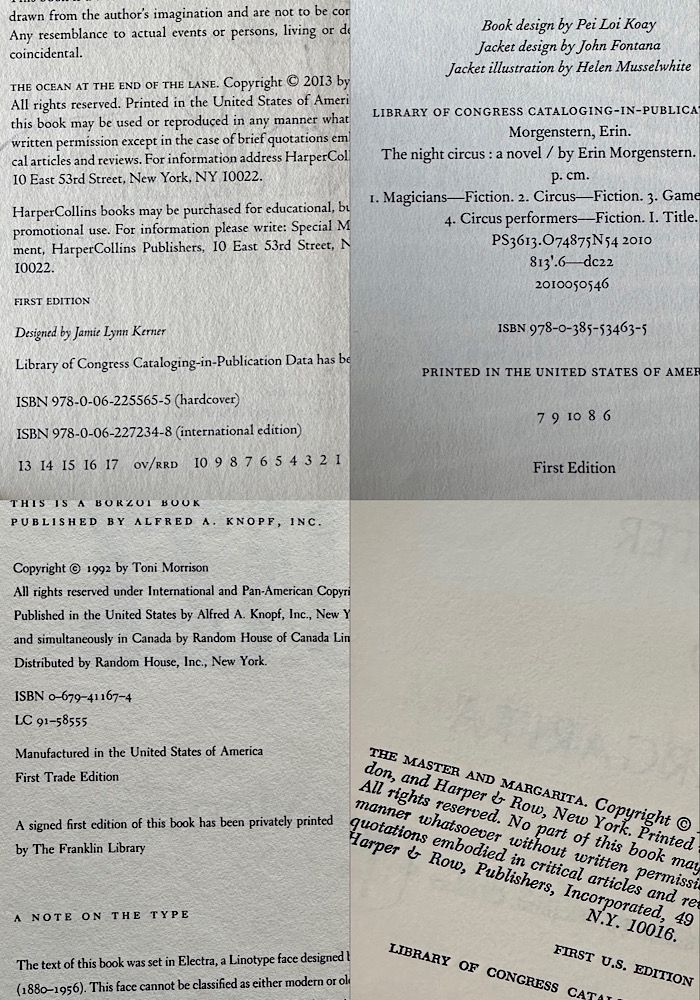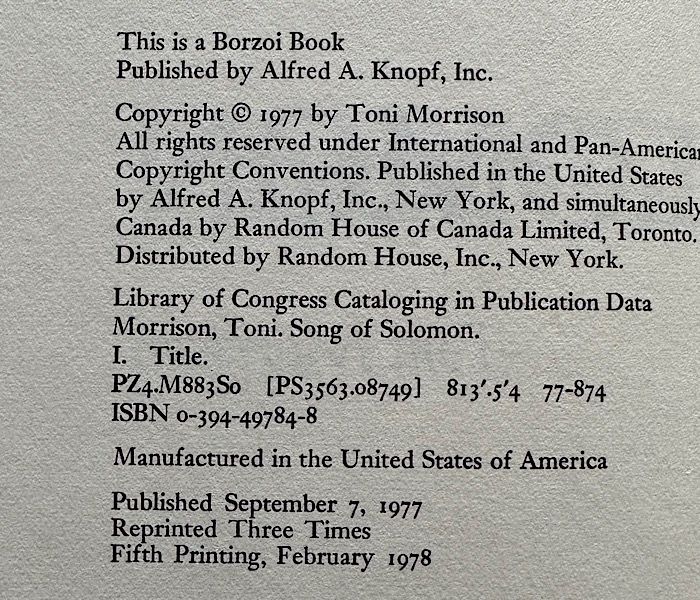I’m a passionate book collector who, like many a book collector, spends a little too much money hoarding books like a dragon. I have books under my bed and in my closet — whenever I buy a new piece of furniture, I try to make sure it has a space for me to stick some books. I’ve hunted down more than one first edition — from stumbling on a Toni Morrison gold mine at a used bookstore (I bought both Jazz and Paradise, my two Morrison favorites) to my long and difficult search for a gorgeous UK hardcover edition of Uprooted. So, I’m in a good place to walk all of you through how to find first edition books, whether online or in-person.
Take it from an expert with an unhealthy number of Neil Gaiman first editions on her bookshelf: you can do this, and it will be awesome when you find the book you’re looking for!
How to Find First Edition Books: Getting Started
First things first: definitions and identification. A first edition is the very first cover, design, format, etc., that a book is published with. A first printing is the very first round of books printed.
For example, if a publisher does a print run of 10,000 copies for a book’s debut, and they all sell out instantly, the publisher goes back for a second printing, say of another 20,000 copies.
Both printings are first editions because they’re printing the same book with no new material or changes. However, the second printing is usually less valuable than the first. Particularly if the book was an unexpected bestseller or hit, the first print run might have been more modest, and so, more rare. But also, it’s just the first version of the book, the earliest edition, to hit the market, so it’s a more valuable collector’s item. Some small things can change between printings: a typo caught here, a new paper stock, a slightly different color font, for example.
This can be a boon, depending on what you’re looking for out of your first edition search. I was able to buy my dad a signed first edition, 11th printing of Lonesome Dove that would have been way, way out of my budget if it was first edition, first printing. It’s worth looking for this, because if it is listed, it means that there’s a first printing out there.
So what makes a second edition? A new edition comes with a significant change to format (a switch to paperback or hardcover, a new cover, a fancier cover or thicker pages) or to the text (a new introduction or afterword, discussion questions for the reader, bonus material).
Info Gathering
I often use Goodreads to figure out the things I need to know. Every book page will say when a book was “first published.”
|
|
You can then use “More Editions” to find the right edition — the one that was published on that “first published” date.
 |
Note down the cover shown, the format, the published date and publisher, and even the ISBN to help you search for this first edition.
How to Identify a First Edition In-Person
Open up to the copyright page of the book. In an ideal world, you’ll read through it, and somewhere, it will say “First Edition.” Easy-peasy, now you can decide whether the listed price is in your budget or not. Here are some examples:
 |
Things to watch out for:
The printing: Look at the top left in my photo example. See those numbers at the bottom? Those are printing numbers. They count down from 10. The lowest number they hit is the print run. For example, my copy of The Ocean at the End of the Lane, above, is a first edition and first printing. My copy of The Night Circus, on the top right, is a first edition, but 6th printing.
First printings are more valuable — but on the opposite end, later printings are more affordable for many book collectors’ budgets.
Some older books make it a bit easier by listing the printing straight up, like with my Toni Morrison book below.
 |
“First Paperback Edition”: Notes like this are incredibly useful because this usually means that there was a true First Edition somewhere else, before this version came out — but if you’re collecting all first editions of the book, this paperback would potentially count!
To the chagrin of many a book collector, seeing nothing related to editions and printing usually means that it isn’t a first edition or notable edition at all. But try to know your details, if you can — what year did the book debut? What publisher did their first edition? Were there special editions that came out at the same time as the first hardcover? (For a more in-depth guide to these details of first editions, check out Biblio’s guide.)
Looking In-Person
Haunt local bookstores! Have the list of first editions you’re looking for in your phone or in an easily accessible Google doc that you can click open at all times, and include useful notes like a photo of the right cover or dust jacket, the date the book was published, and the publisher.
Look at any used bookstores near you, and when or if you travel, visit any used or rare bookstore in the neighborhood. I’ve generally had more success at used bookstores than rare ones because it’s easier to find a hidden gem or jewel, but obviously, the rare bookstores are where the best finds will often be found. Some big stores, like The Last Bookstore in California, have excellent rare books sections in addition to their usual selection.
Some used bookstores have a wishlist or request list where you can ask to be notified if a particular book or edition comes in! For example, my local bookstore Uncharted Books has a form you can fill out to request to be informed of new arrivals in certain categories. Russell Books, the largest used and new bookstore in Canada, has a request list if you’re looking for a particular book.
Browsing in-person gives you a lot more control because you can see the condition of the book and verify its first edition nature up close and personal, which is really helpful. But obviously, it’s a little tougher to compare prices or try to find a deal.
Looking Online
The upside of looking for first editions online is fast and easy access to a wide range of places that sell used books: ABE Books, ThriftBooks, Half-Price Books, eBay, and more. You might even be able to track one down in the “used” section on Amazon. (Other book collectors and I often favor ABE, because it allows you to filter your search for “first edition” and combine it with a search for “dust jacket,” which makes it easy to start strong!)
The downsides are that you can’t verify things yourself! Sometimes a website will post a “first edition,” but they have the wrong cover posted. Sometimes, it’s the right cover, but they specify in the notes that there’s no dust jacket. Sometimes, the store makes a mistake like the one I mentioned above — they list it as a first edition, but when it arrives in the mail, you discover that it’s actually the first edition under a second publisher or the first paperback edition, or the first U.S. edition when you wanted the original UK edition.
 |
So here are my tips:
- Read the book description carefully. Check for date and publisher, and check against when the first edition was first published.
- Check the book’s condition carefully. Some stores have different definitions of “good” or “fair.” Consider what’s important to you, and whether you need a pristine one or whether one with a faded dust jacket and light wear on the pages would be just fine.
- Make sure there is a dust jacket. Often, there isn’t, especially when it’s older! If the picture of the item is a generic cover photo (vs. a real-life snap of the book in question), don’t trust that photo to tell you what edition it is.
Figuring Out a Fair Price
Another good tip: on eBay, you can check what previous comparable items sold for! Search for a first edition of the book. There will be a toolbar on the left side of the page. Scroll all the way down to “Show options” and click “Sold items.” This will show you what previous examples or similar ones have sold for, which will help you see if you’re looking at a fair price.
Ultimately, remember: some people will sell high because they only want to let it go if they can get X price. Some people will sell low. The right price is the price that you’re up to pay for the book. I’ve “overpaid” or “splurged” for a first edition or two that I’d been searching for over the course of years — time and scarcity are valid reasons to raise the selling price.
In Conclusion
Do your research, keep careful notes, and happy collecting!
Want to read other pieces on book collecting? Try this essay on how books become valuable, or read about how to start an intentional book collection.
And keep me updated on your first edition search on Twitter!
Source : How to Find First Edition Books













